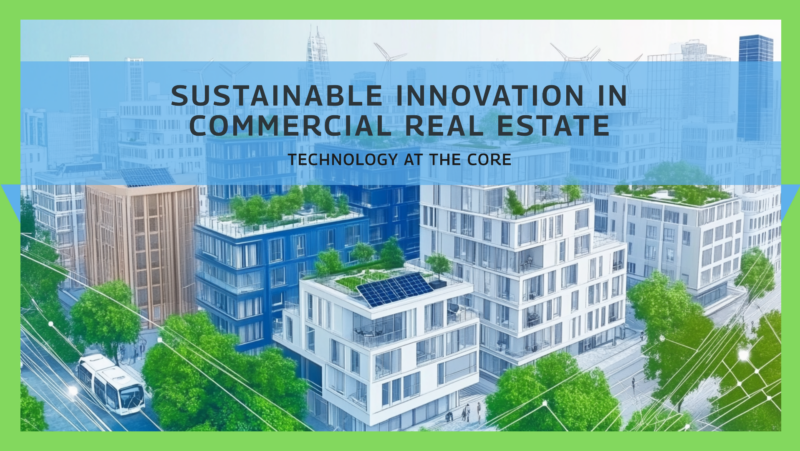
Sustainability has evolved from a trend to an essential pillar of success in commercial real estate. The rising demand for eco-friendly commercial spaces reflects a shift driven by both regulatory pressures and changing market expectations. Governments are enforcing stricter building codes, while tenants and investors increasingly prioritize environmental responsibility in their decision-making processes. This shift is reshaping how real estate is developed, managed, and valued.
At the core of this transformation is sustainable innovation—integrating eco-friendly technologies, smart building systems, and green certifications that contribute to both environmental goals and financial performance. Sustainable practices are not just about minimizing carbon footprints; they are also about improving asset value, enhancing tenant appeal, and creating more efficient, future-proof developments.
In this article, we will explore key components of this movement, from green building certifications like LEED and BREEAM to renewable energy solutions and smart technologies that improve energy efficiency. We’ll discuss how sustainability can act as a business strategy, boosting ROI, lowering total cost of ownership, and enhancing brand equity. Finally, we’ll dive into the intersection of technology and sustainability, where innovations such as IoT-enabled smart systems are reshaping the future of commercial real estate.
By the end, we hope to make a compelling case for why sustainability isn’t just good for the planet—it’s also great for business.
The Role of Green Building Certifications
Green building certifications such as LEED (Leadership in Energy and Environmental Design), WELL, and BREEAM (Building Research Establishment Environmental Assessment Method) have become essential benchmarks in validating sustainable practices within commercial real estate. These certifications assess a building’s environmental performance across areas like energy use, water efficiency, and indoor environmental quality, offering both recognition and practical guidance for sustainability.
Achieving certification can significantly enhance a building’s market value and tenant appeal. Certified buildings are often viewed as premium assets, attracting environmentally conscious tenants willing to invest in spaces that align with their values. Additionally, these certifications boost long-term asset performance by reducing operational costs, improving energy efficiency, and future-proofing the property against regulatory changes.
“Green certifications like LEED not only validate sustainable practices but also help build trust with tenants and investors seeking long-term, eco-friendly investments.”
A notable example is the Empire State Building, which earned LEED Gold certification after a multi-million dollar retrofit. By integrating energy-efficient systems and sustainable materials, the project reduced the building’s energy use by 38%, positioning it as a leading example of how certification can enhance value and sustainability simultaneously.
Innovative Energy Solutions for Eco-Friendly Spaces
Renewable Energy Adoption
The adoption of renewable energy sources like solar, wind, and geothermal is transforming how buildings operate. Solar panels on rooftops, wind turbines in energy-efficient parks, and geothermal systems that heat and cool buildings sustainably are becoming increasingly popular. As green real estate continues to rise, explore how these innovations are shaping the future in the article, Building the Future: The Rise of Green Real Estate.
These systems offer substantial benefits, including reduced energy costs, enhanced environmental performance, and compliance with green building regulations.
Energy-Efficient Technology
Technologies such as IoT-enabled smart systems play a critical role in reducing energy consumption. Intelligent HVAC systems, smart lighting, and automated energy management platforms optimize resource usage by adjusting settings based on real-time conditions and usage patterns.
“Predictive maintenance and AI-driven building management systems help not only in optimizing energy efficiency but also in preventing costly equipment failures, ensuring that buildings are as sustainable as they are efficient.”
These advanced technologies contribute to energy savings, improved building performance, and long-term sustainability, making them essential for eco-friendly commercial real estate.
Sustainability as a Business Strategy
The Financial Benefits of Sustainable Practices
Sustainability is not just an ethical responsibility; it is a strategic business decision with measurable financial benefits. Long-term cost savings are realized through reduced energy consumption and enhanced operational efficiency. Sustainable building practices lead to lower energy bills, fewer maintenance issues, and reduced environmental impact, contributing to a better ROI and lower total cost of ownership (TCO). Companies like Google and Microsoft, which invest in green buildings, have reported both financial and operational rewards from adopting eco-friendly strategies. To learn more about how PropTech is transforming sustainability in real estate, check out the article Sustainability and PropTech: A Green Revolution in Real Estate from Springboard.com.
Brand Equity and Market Differentiation
Sustainability also plays a crucial role in enhancing corporate social responsibility (CSR) efforts and bolstering brand reputation. By adopting sustainable innovation, companies differentiate themselves in the market, appealing to environmentally conscious investors and high-profile tenants.
“Sustainability isn’t just about doing what’s right for the planet—it’s about doing what’s right for business in the long term.”
This approach improves market appeal and positions firms as leaders in the growing green economy, attracting tenants and investors who prioritize environmental stewardship.
Embracing a Future Mindset: Technology in Commercial Real Estate | Layer 10
The Intersection of Sustainability and Smart Buildings
Smart building technologies are playing a pivotal role in advancing sustainability. These systems, which integrate automation and data analytics, enable buildings to optimize resource use, reduce energy waste, and enhance environmental performance.
From smart HVAC systems that automatically adjust based on occupancy levels to intelligent lighting systems that conserve energy, these technologies reduce environmental footprints while cutting operational costs.
“Data-driven automation allows buildings to be more responsive, ensuring that sustainability goals are met without sacrificing efficiency or comfort.”
By harnessing real-time data, building managers can continuously refine operations, making sustainable goals more achievable and efficient.
Conclusion
Sustainability is no longer an optional consideration in commercial real estate—it’s essential to long-term success. By embracing green building certifications, renewable energy solutions, and energy-efficient technologies, companies are positioning themselves for both financial and environmental benefits. Smart building technologies are transforming how resources are managed, driving efficiency and lowering costs.
As the industry continues to evolve, now is the time to invest in sustainable innovation. If you’re ready to explore how these strategies can enhance your projects, consult with Layer 10 for expert guidance in integrating sustainable technologies.
Let’s build tomorrow, today.